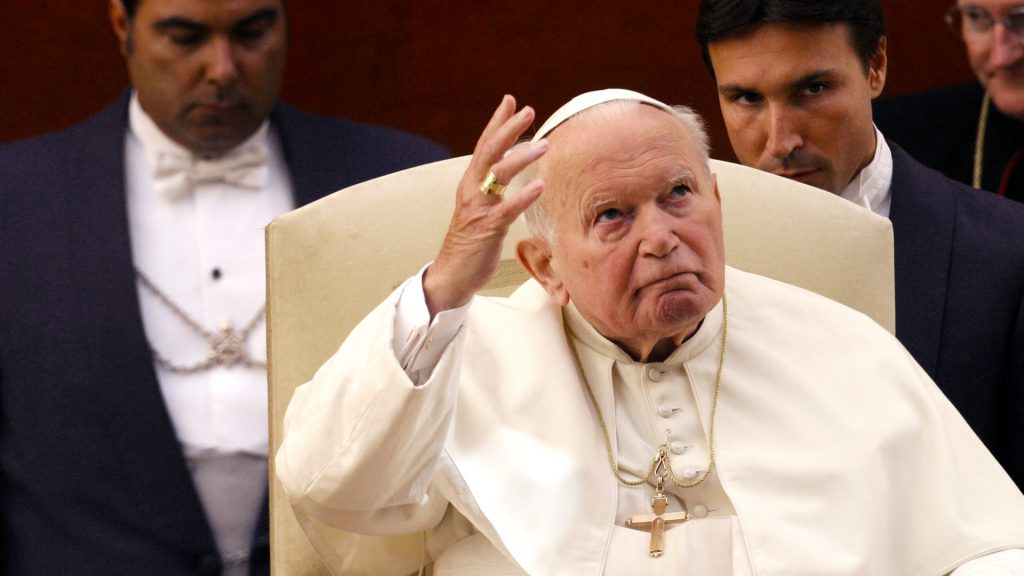
Published May 14, 2020
Next Monday, May 18, marks the 100th anniversary of the birth of Karol Wojtyła. Pope Francis will mark the occasion by celebrating Mass at the saint’s tomb in St. Peter’s Basilica. Other celebrations, many planned long in advance, have been curtailed by the pandemic. Even without the pandemic, however, the centenary might strike some of us as anti-climactic. What happened to the “new springtime for the Church” we were promised?
I am old enough to remember the enthusiasm and vitality of John Paul II’s early pontificate. Here was a man of parts: A mystic who survived the assassin’s bullets, a philosopher-priest who bested the Communists, and a young reformer who returned a semblance of stability to the Church after the tumultuous years following the Second Vatican Council.
Above all, here was a Christian disciple whose confidence and charisma emanated from a source even more attractive than the man himself.
I am also young enough to realize that many Catholics who are my age or younger remember Pope John Paul II in a different way. He was to them – if they have any living memory of him at all – a frail old man, whose physical infirmities may have been evidence of interior sanctity and redemptive suffering. But those infirmities also serve, especially in hindsight, as a kind of metaphor for the state of the Church and the world he left upon his death.
By the time Pope John Paul II died in 2005, the notion of the End of History was, itself, most definitely at an end. History, with a capital “H” was back with a vengeance. And the ecclesial confidence which was one of the hallmarks of the John Paul II Generation had been deeply shaken – and in some cases, shattered – by the abuse crisis of 2002 and the subsequent, slow realization that ecclesial free-for-all of the late 1960s and 1970s had not gone away for good.
The release of the Vatican report on Theodore McCarrick – if and when it is released – is likely to bring our attention back to such matters. McCarrick was already a bishop when Karol Wojtyła was elected in 1978, but it was John Paul II who appointed him three times to successively larger and more influential sees. And he gave McCarrick his red hat in 2001.
The Church should not be afraid to take an unflinching look (with all the humility appropriate to those who would judge the past) at what Pope John Paul II got wrong and what he got right. And why.
We know that reports of at least some of McCarrick’s offenses had reached Rome by the time he was made Cardinal. Were those red flags simply ignored, or dismissed as unsubstantiated rumors? Did those reports ever reach the pope, or were they filtered out by those around him who could have done so? These are some of the questions we can only hope the McCarrick report will help to answer.
No answer to these questions is likely to reflect well on John Paul II. Ultimately, the failure to detect, let alone discipline, McCarrick’s perfidy happened during his pontificate, and under the noses (possibly even with the complicity) of those the pope trusted to help him guide the Church.
John Paul II also deserves some credit, however. Many of the policies we think of as baselines for dealing with abuse were initiated under John Paul II. For example, the implementation of a “zero-tolerance policy,” which was first granted here in the United States in 1994 (and was in force nationally as of 2002) was a drastic step – one that is still not in force universally in the Church today.
And in 2001, the pope made sure that cases involving sexual crimes committed by clergy against minors were reserved exclusively to the jurisdiction of the Congregation for the Doctrine of the Faith. That same year, he did something no pope had done before: he publicly apologized on behalf of the Church for clerical sexual abuse.
Taking such steps might seem the obvious course action to us in 2020, but they were significant and even underappreciated changes at the time.
And it is worth remembering, too, that instances of abuse began to fall precipitously in the United States just after John Paul II was elected. Some credit for this goes to John Paul II for the way he reshaped seminary formation, (especially through Pastores Dabo Vobis), his theology of the priesthood, and the kind of priestly fatherhood he modeled personally.
Pope Francis has promised to “follow the path of truth wherever it may lead.” I say those of us who have benefitted so greatly from John Paul II’s accomplishments – and from his intercession now – ought to be equally willing to learn from his failings, too. It would be a pity if we were not so willing. We have nothing to lose and much to gain from the truth.
Next week, I plan to celebrate with gratitude the centenary of my beloved JP2. I will ask his intercession for the Church he loves so well, even as I ponder on two of his more frequent admonitions: “Be not afraid.” And, “The truth will set you free.”
Pope Saint John Paul II, pray for us.
© 2020 The Catholic Thing.
Stephen P. White is executive director of The Catholic Project at The Catholic University of America and a fellow in Catholic Studies at the Ethics and Public Policy Center.











